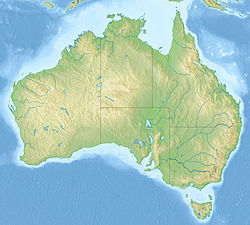| Wallumbilla Formation | |
|---|---|
| Stratigraphic range: Aptian-Albian, ~ | |
| Type | Geological formation |
| Unit of | Rolling Downs Group |
| Sub-units | Trimble Member, Ranmoor Member, Jones Valley Member, Doncaster Member, Coreena Member |
| Underlies | Toolebuc & Griman Creek Formations |
| Overlies | Cadna-Owie & Bungil Formations |
| Thickness | 600 m (2,000 ft) |
| Lithology | |
| Primary | Mudstone, siltstone |
| Other | Sandstone, limestone |
| Location | |
| Coordinates | 20°48′S143°42′E / 20.8°S 143.7°E |
| Approximate paleocoordinates | 60°12′S124°24′E / 60.2°S 124.4°E |
| Region | New South Wales Northern Territory Queensland South Australia |
| Country | Australia |
| Extent | Eromanga Basin |
The Wallumbilla Formation is an Aptian geologic formation found in Australia. Plesiosaur and theropod remains are among the fossils that have been recovered from its strata.
